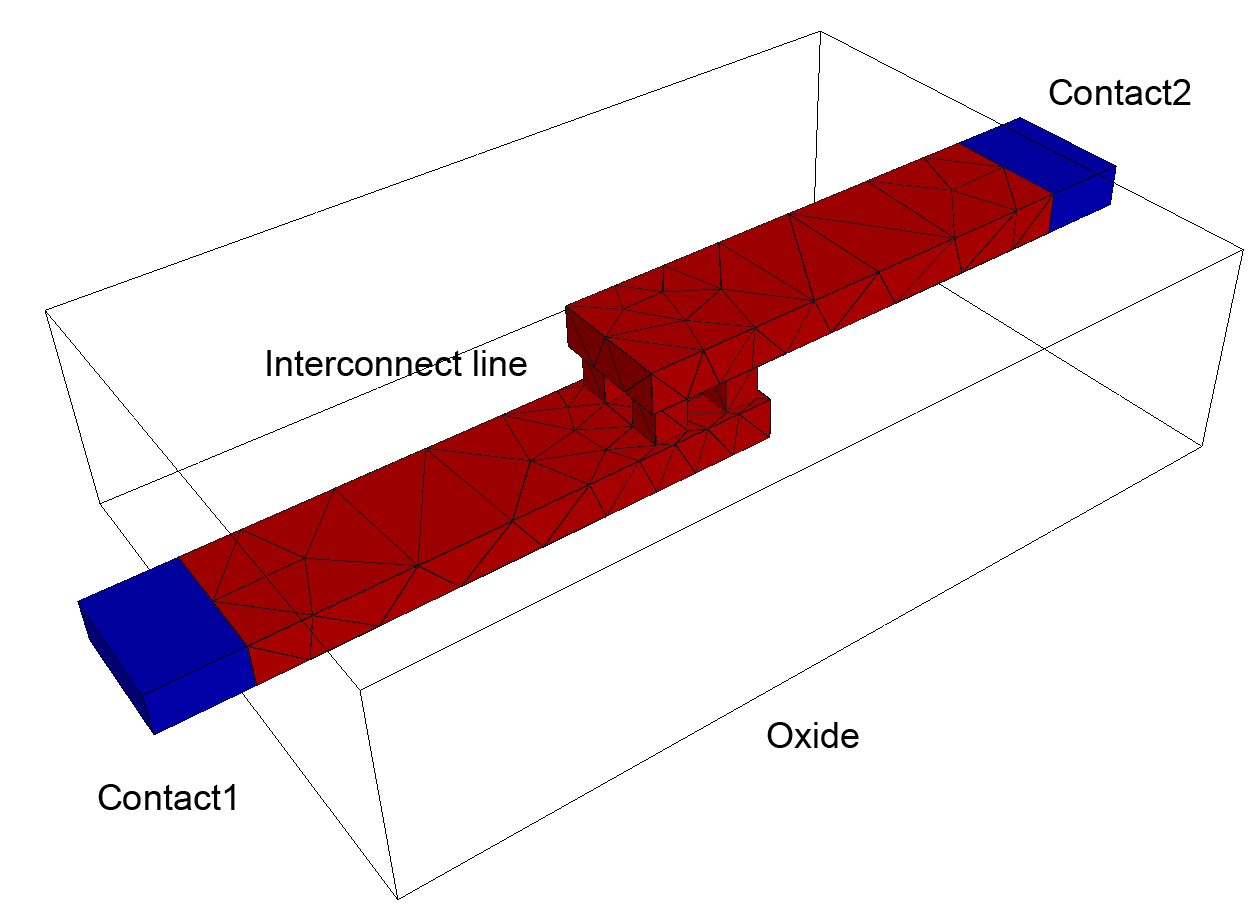 |
To overcome the difficulties encountered in the modeling of three-dimensional structures, the Vienna Geometry Modeler (VGM [137]) was developed. It enables an efficient means for structure generation for interconnect simulation, and can be seen as a successor of LAYGRID [114] from the SAP-package. The creation of objects is based on a constructive solid geometry (CSG) approach which models complex three-dimensional shapes using simple objects. The agglomerations of these simple objects then provide suitable simulation structures. To give a brief overview of the syntax and mannerism of VGM, a comparison of a LAYGRID file and a VGM input file are presented next.
First, the LAYGRID input file is presented:
lengthunit { 1.0 um }
mask { MASK0
rectangle { FX0 SIOX { 0.0 0.0 } { 10.5 6.5 } }
}
mask { MASK1
rectangle { FX1 SIOX { 0.0 0.0 } { 10.5 6.5 } }
rectangle { FX2 ALX { 0.0 2.5 } { 6.0 1.5 } }
rectangle { FX2C ALX { 0.0 2.5 } { 1.0 1.5 } }
}
mask { MASK2
rectangle { FX3 SIOX { 0.0 0.0 } { 10.5 6.5 } }
rectangle { FX4 AVX { 4.6 2.6 } { 0.4 0.4 } }
rectangle { FX4 AVX { 5.5 2.6 } { 0.4 0.4 } }
rectangle { FX4 AVX { 4.6 3.5 } { 0.4 0.4 } }
rectangle { FX4 AVX { 5.5 3.5 } { 0.4 0.4 } }
}
mask { MASK4
rectangle { FX3 SIOX { 0.0 0.0 } { 10.5 6.5 } }
rectangle { FX4 AVX { 4.6 2.6 } { 0.4 0.4 } }
rectangle { FX4 AVX { 5.5 2.6 } { 0.4 0.4 } }
rectangle { FX4 AVX { 4.6 3.5 } { 0.4 0.4 } }
rectangle { FX4 AVX { 5.5 3.5 } { 0.4 0.4 } }
}
mask { MASK5
rectangle { FX9 SIOX { 0.0 0.0 } { 10.5 6.5 } }
rectangle { FX10 ALX { 4.5 2.5 } { 6.0 1.5 } }
rectangle { FX10C ALX { 9.5 2.5 } { 1.0 1.5 } }
}
mask { MASK6
rectangle { FX11 SIOX { 0.0 0.0 } { 10.5 6.5 } }
}
layerstructure {
origin { 0 0 0 }
plane { ------------ }
layer { MASK0 0.5 }
plane { ------------ }
layer { MASK1 0.5 }
plane { ------------ }
layer { MASK2 0.25 }
plane { ------------ }
layer { MASK4 0.25 }
plane { ------------ }
layer { MASK5 0.5 }
plane { ------------ }
layer { MASK6 0.5 }
plane { ------------ }
}
Next, the VGM input file is presented:
line { OB dummy { 0 0 0 }{10 6.5 2.5 } }
line { ODL dummy {-10 0 0 }{10 6.5 2.5 } }
line { OXR dummy { 10 0 0 }{10 6.5 2.5 } }
tapered { LB1 dummy {-1 2.5 0.5}{ 7 1.5 0.5}{0.0}{0.0}}
tapered { LB2 dummy { 4.5 2.5 1.5}{6.5 1.5 0.5}{0.0}{0.0}}
tapered { VB1 dummy { 4.6 2.6 0.9}{0.4 0.4 0.7}{0.0}{0.0}}
tapered { VB2 dummy { 5.5 2.6 0.9}{0.4 0.4 0.7}{0.0}{0.0}}
tapered { VB3 dummy { 4.6 3.5 0.9}{0.4 0.4 0.7}{0.0}{0.0}}
tapered { VB4 dummy { 5.5 3.5 0.9}{0.4 0.4 0.7}{0.0}{0.0}}
solid { LT1 dummy { OB & LB1 } }
solid { LT2 dummy { OB & LB2 } }
solid { O1 SiO2 { OB-LB1-LB2-VB1-VB2-VB3-VB4}}
solid { CF1 Al { ODL & LB1 } }
solid { CF2 Al { OXR & LB2 } }
solid { LF Al { LT1 + LT2 + VB1 + VB2 + VB3 + VB4}}
contact { Contact1 electric 1.0 V {CF1} }
contact { Contact2 electric 0.0 V {CF2} }
An additional feature of the VGM specification is that tapering angles of the given sidewalls can be easily adjusted. Only the corresponding skewness parameters have to be adjusted, given in the following lines:
// xskew yskew
tapered { VB1 dummy { 4.6 2.6 0.9}{0.4 0.4 0.7} {0.0} {0.0}}
tapered { VB1 dummy { 4.6 2.6 0.9}{0.4 0.4 0.7} {0.2} {0.2}}